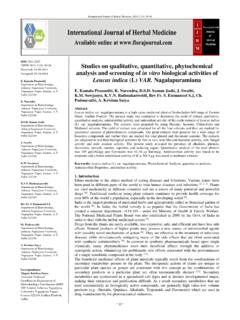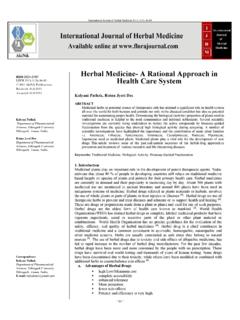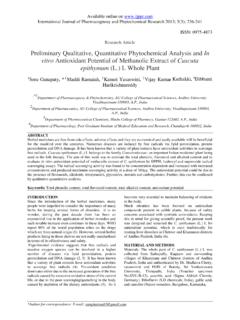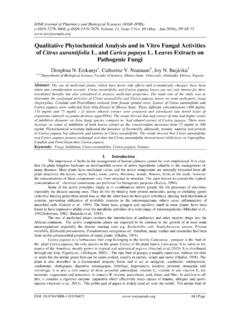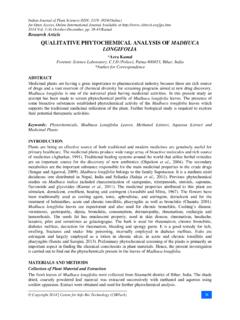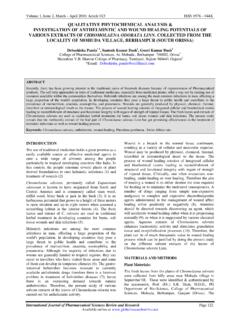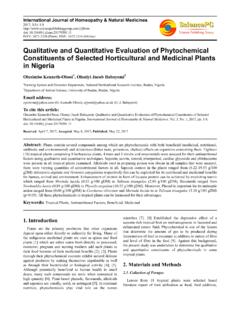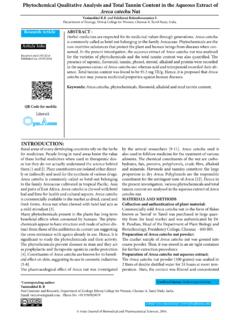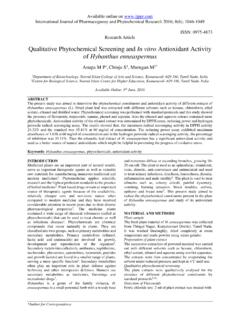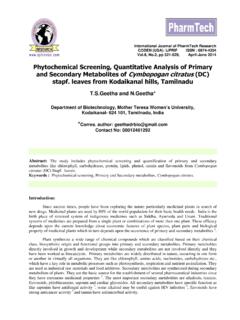Transcription of Phytochemical analysis and medicinal uses of Hibiscus
1 ~ 16 ~ International Journal of Herbal Medicine 2015; 2 (6): 16-19 E- ISSN: 2321-2187 P- ISSN: 2394-0514 IJHM 2015; 2 (6): 16-19 Received: 31-01-2015 Accepted: 08-04-2015 Okereke CN Department of Applied Biology, Ebonyi State University Abakaliki, Ebonyi State Nigeria. Iroka FC Department of Botany, Nnamdi Azikiwe University, P. M. B 5025 Awka, Anambra State Nigeria. Chukwuma MO Department of Biology, Nwafor Orizu College of Education, Nsugbe, Anambra State Nigeria. Correspondence: Iroka FC Department of Botany, Nnamdi Azikiwe University, P. M. B 5025 Awka, Anambra State Nigeria. Phytochemical analysis and medicinal uses of Hibiscus sabdariffa. Okereke CN, Iroka FC, Chukwuma MO. Abstract The Phytochemical analyses, nutrient value and economic importance of Hibiscus sabdariffa commonly known as Zobo plant was carried out.
2 In Nigeria the plant is used to make a popular beverage known as Zobo drink. Investigations revealed that the plant is highly rich in vital minerals and nutrients such as Iron, copper, calcium, magnesium, manganese required for healthy growth in humans. The phytochemicals were extracted from the dried calyces of Hibiscus sabdariffa using solvent extraction method. The preliminary Phytochemical analysis showed that there are some plant chemicals present in the extract such as alkaloids, tannins, saponnins, glycosides, phenols and flavonoids and quantitative result revealed their presence as follows; Tannins ( ), saponnins ( ), phenols ( ), glycosides ( ), alkaloids ( ) and flavonoids ).
3 Hibiscus sabdariffa has medicinal benefits as it causes reduction in hypertension and cholesterol. The plant is economically important for proper metabolic process to be adequately maintained. It was discovered that the dietary constituents contributing to the protective effects of these plant materials are plant secondary metabolites in the form of phytochemicals, vitamins and minerals. medicinal and aromatic plants contain biologically active chemical substances such as saponins, tannins, glycosides and other chemical compounds which have curative properties. This study suggests that plant derived medicines are relatively safer than synthetic alternative offering profound therapeutic benefits and more affordable treatment, hence, Hibiscus sabdariffa is readily available to provide such benefits.
4 Keywords: Hibiscus sabdariffa, Phytochemicals, Infusion, Zobo drink. 1. Introduction Hibiscus sabdariffa is a species of Hibiscus , native to the old world tropics, used for the production of bast fiber and as an infusion (herbal tea). The plant is an annual or perennial herb or woody-based sub-shrub, growing up to m (7-8 ft) tall. The leaves are deeply 3-5 lobed, 8-15 cm long arranged alternatively on the stems [1]. The flowers are 8-10 cm in diameter, white to pale yellow with a dark red spot at the base of each petal and have a stout fleshy calyx at the base 1-2 cm wide, enlarging to cm, fleshy and bright red as the fruit matures. It takes about 6months to mature [2]. The plant is widely cultivated for its strong fibers and it is well known for its edibility and medicinal properties, though the calyx is the most frequently used portion of the plant, the leaves and seeds are often made into salads, curries and potherbs [3].
5 They are rich in vitamins, natural carbohydrate, protein, tannins, gums and other antioxidants including minerals [4]. The chemistry of the calyx revealed that per 100 g, it contained 49 calories, water, protein, g fat, g total carbohydrate, g fiber, g ash, mg calcium, 57 mg phosphorus, mg iron, 300 g vitamin A equivalent and 14mg ascorbic acid [1]. Hibiscus sadariffa has common names such as Roses of anthea African mallow , Roselle , Rose mallow , Indian sorrel , Flore de Jamaica and Jamaica tea [5]. Hibiscus sabdariffa is known as Roselle in Australia, Tengamoran in Asam, Gongura in Hindi, Krajeab in Thailand, Bissap in Senegal, Guinea Bissau, Mali, Burkina Faso, Ghana, Benin, Niger, Congo and France.
6 Wonjo in Gambia, Torosh in Iran, Sorrel in Carribean, Karkade in Egypt, Asam Paya in Malaysia, Luoshen Hua in Chinese, Lamanda in Zambia and Zobo in Nigeria [6]. The fruits are surrounded by enlarged fleshy calyces containing 22-34 seeds per capsule. The seeds are dark brown in colour, 4-6cm long and about g in weight, grow up to 2 meters and leaves vary in shape and size [7]. There are more than 200 species in all over the world [2]. Hibiscus sabdariffa is cultivated for leaf, seed, fleshy calyx or fiber [8]. The plant is grown in all parts of the world; it is a native to India but was introduced to other parts of the world such as Central America, West Indies and Africa. It is highly cultivated and distributed in the northern part of Nigeria because of favourable ~ 17 ~ International Journal of Herbal Medicine climate [9].
7 Hibiscus sabdariffa is found in tropical and subtropical regions of the world, it is cultivated for its fiber with characteristics similar to those of hemp or jute which is used to make cloth, rope and in Polynesia, grass skirts [10]. Hibiscus sabdariffa plant parts such as seed, stem, leaves and calyces are harvested from late December to February. The harvest is timed according to ripeness of the seed. The fleshy calyces are harvested after the flower has dropped but before the seedpod has dried and opened. The more time the capsule remains on the plant after the seeds begin to ripe, the more susceptible the calyx is to sores, sun cracking and general deterioration in quality [1, 11].
8 Hibiscus sabdariffa Zobo drink has a shelf of life normally 24 to 48 hours after which it begins to deteriorate. It is best preserved by refrigeration which will control the micro-organism reaction on the drink [12]. Due to the ubiquitous nature of micro-organisms, the level of contamination can be reduced if proceeded under standard hygienic conditions and at low temperatures to prevent the multiplication of pathogenic micro organisms that can cause infection to the consumers [13]. Delicate Hibiscus flower requires special handling during and after preservation. The blossoms are fragile and cannot tolerate the pressure from conventional flower pressing. The use of desiccants and silica crystals helps wick away moisture from the petals while still protecting the shape and colour of the bossom of the plant [8].
9 2. Materials and Methods Plant Collection The samples of Hibiscus sabdariffa calyces were collected in February, 2013, at the meat market, Abakaliki in Ebonyi State of Nigeria. The plant was identified by Mr. Okereke, C. N of the Department of Applied Biology at Ebonyi State University, Abakaliki. Extract Preparation Reasonable quantity of the plant Hibiscus sabdariffa calyces were collected and after it identification, the leaves were thoroughly dried and smashed using mortal and piston. The dried powder samples were however used for the various analyses. The extraction of Hibiscus sabdariffa calyces was done using 20g of the grinded calyces sample in soxhlet extractor with distilled water, ethanol, methanol, ethyl, acetate and petroleum ether at Project Development Institute (PDI), Enugu State, Nigeria.
10 Phytochemical analysis The water extract and other extracting reagents such as methanol, ethanol, ethyl acetate and petroleum ether on Hibiscus sabdariffa were subjected to preliminary Phytochemical screening to identify the chemical constituents. Test for the presence of alkaloids, flavonoids, phenols, saponin, steroid, tannin, terpenoids, glycosides, phlobatannins was done using [14] method with some modifications. Quantitative determination of the Phytochemical constituents of the plant was done using gravimetric method described by [14] with some modifications. The determination was carried out on alkaloid, flavonoid, phenols, saponins, tannins and glycosides.
